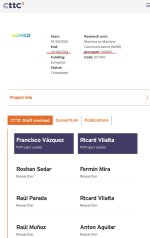BrainChip gets a mention here.
Neuromorphic Computing Market to Reach US$ 20.4 Billion by 2031 Fueled by AI and Edge Intelligence - Persistence Market Research
07-11-2025 09:12 AM CET |
IT, New Media & Software

Neuromorphic Computing Market

Market Set to Expand at 20.9% CAGR Amid Rising Demand for Brain-Inspired Computing in AI and Robotics
According to the latest study by Persistence Market Research,
the global neuromorphic computing market is projected to grow significantly from US$ 5.4 billion in 2024 to US$ 20.4 billion by 2031, exhibiting a robust CAGR of 20.9% over the forecast period. This surge is primarily driven by the growing demand for low-power, high-speed computing systems, especially in artificial intelligence (AI), edge computing, and advanced robotics. Neuromorphic systems mimic the architecture and operational principles of the human brain, enabling real-time data processing and cognitive functions with significantly reduced energy consumption.
Neuromorphic computing systems are rapidly gaining traction in industries that require ultra-efficient data processing such as defense, healthcare, automotive, and industrial automation. The market is being propelled by advances in hardware design, particularly the integration of neuromorphic chips with AI frameworks, enabling improved pattern recognition, decision-making, and adaptation in uncertain environments. The edge computing segment leads the market due to the rising need for real-time inference at the device level without relying heavily on cloud infrastructure. Geographically, North America dominates the neuromorphic computing landscape, largely due to its early adoption of AI technologies, strong presence of tech giants, and heavy R&D investments in next-generation computing platforms.
Get a Sample PDF Brochure of the Report (Use Corporate Email ID for a Quick Response):
https://www.persistencemarketresearch.com/samples/34726

Key Market Insights
➤ The neuromorphic computing market is set to grow more than 3.7x by 2031, driven by AI and IoT integration.
➤ Edge computing is the dominant segment due to its synergy with neuromorphic hardware for real-time decision-making.
➤ North America leads globally, thanks to extensive research initiatives and a strong base of semiconductor innovation.
➤ Increasing deployment of neuromorphic processors in autonomous vehicles and robotic systems boosts market expansion.
➤ Startups and tech giants alike are investing in neuromorphic chip development for next-gen intelligent applications.

What is the future of neuromorphic computing in AI applications?
Neuromorphic computing is expected to play a pivotal role in advancing AI applications by offering real-time learning, adaptability, and energy efficiency, which traditional Von Neumann architectures cannot match. With AI models becoming more complex, neuromorphic systems provide faster processing at lower power, especially suitable for applications in autonomous driving, smart surveillance, robotics, and edge analytics. Their brain-inspired structure enables efficient handling of unstructured data, noise tolerance, and dynamic decision-making-traits essential for developing human-like machine intelligence. As demand for smarter, faster, and greener AI grows, neuromorphic computing will become central to the next wave of AI innovation.

Market Dynamics
Drivers: The surge in AI-driven applications, the growing use of smart sensors and devices, and the push toward efficient edge computing are key drivers for the neuromorphic computing market. These systems offer unparalleled processing efficiency and are ideal for real-time applications like smart surveillance, industrial robotics, and autonomous vehicles, where latency and power efficiency are critical.
Market Restraining Factor: Despite the promise, the market faces significant challenges in terms of scalability, software compatibility, and lack of standardized programming frameworks. Neuromorphic systems require a different approach than traditional computing models, which can slow down adoption among enterprises not equipped to handle such architectural shifts.
Key Market Opportunity: The most promising opportunity lies in the integration of neuromorphic hardware in edge AI systems, particularly in sectors such as defense, automotive, and healthcare. As edge devices become more autonomous, neuromorphic processors can offer localized intelligence with minimal power draw, enabling new applications in wearable tech, drones, and real-time diagnostics.

Market Segmentation
The neuromorphic computing market is segmented by component, application, end-use industry, and deployment. By component, the market is categorized into hardware (neuromorphic chips and sensors) and software (learning algorithms and frameworks). Hardware holds the dominant share due to ongoing innovations in neuromorphic chips and their adoption in edge and AI devices. Neuromorphic sensors, capable of capturing data in a brain-like manner, are also seeing rapid uptake in autonomous navigation and surveillance applications.
Based on application, the market includes image recognition, signal processing, data mining, object detection, and others. Among these, image and signal recognition applications lead, particularly in automotive and healthcare sectors where real-time interpretation is crucial. In terms of end-use, automotive, aerospace & defense, healthcare, consumer electronics, and industrial automation are key sectors. Automotive, particularly in self-driving and driver-assistance systems, is leading due to the need for rapid, low-latency decision-making. Software advancements that enable real-time learning and self-optimization are also fostering deeper neuromorphic adoption across new AI use cases.

Regional Insights
North America remains the most dominant region in the neuromorphic computing market, supported by the presence of major semiconductor companies, high research investments, and rapid deployment of AI applications. The U.S. is leading the region with substantial funding for defense and AI-focused neuromorphic innovations, including partnerships between universities, startups, and government bodies.
Europe is showing strong momentum, particularly in automotive and robotics applications, with countries like Germany and the U.K. leading in research and development. Asia Pacific is an emerging hotspot, driven by rising tech adoption in China, Japan, and South Korea. These countries are heavily investing in AI, IoT, and next-gen chip manufacturing. Additionally, increased demand for smart electronics and autonomous technologies in the region presents significant future growth potential.

Competitive Landscape
The competitive landscape in the neuromorphic computing market is characterized by strategic collaborations, patent-driven innovation, and a race to commercialize neuromorphic hardware. Companies are also focusing on hybrid architectures that combine traditional and neuromorphic elements to ease the transition and expand use cases.

Company Insights
✦ Intel Corporation
✦ IBM Corporation
✦ BrainChip Holdings Ltd.
✦ Qualcomm Inc.
✦ Hewlett Packard Enterprise Development LP
✦ Samsung Electronics Co., Ltd.
✦ HRL Laboratories, LLC
✦ Nepes Corporation
✦ General Vision Inc.
✦ SynSense AG
✦ Applied Brain Research, Inc.
For Customized Insights on Segments, Regions, or Competitors, Request Personalized Purchase Options @
https://www.persistencemarketresearch.com/request-customization/34726

Key Industry Developments
Recent years have witnessed several key developments shaping the neuromorphic computing market. Intel's Loihi neuromorphic chip has been central to various research collaborations, showing promise in edge AI and robotics. IBM, through its TrueNorth chip project, continues to pioneer in neural-inspired computing, aiming to scale commercial applications. Meanwhile, BrainChip's Akida chip is gaining traction across smart home and security device manufacturers for its energy-efficient inference capabilities.
The market is also experiencing growing academic-industry collaborations. Universities and research labs are partnering with tech companies to develop programmable neuromorphic platforms, making it easier for developers to create applications that utilize spiking neural networks (SNNs). These developments are gradually making neuromorphic computing accessible to a broader tech community.

Innovation and Future Trends
Innovation in neuromorphic computing is centered on spiking neural networks (SNNs), 3D chip stacking, and on-device learning. Researchers are exploring how to develop chips that can learn from their environment in real time-much like biological brains. Unlike traditional AI models that require vast data centers, these innovations focus on real-world interaction and decision-making at ultra-low power, making neuromorphic devices ideal for mobile and wearable technologies.
Future trends indicate a shift toward neuromorphic-as-a-service platforms, where enterprises can access neuromorphic capabilities without building custom hardware. Furthermore, as AI grows increasingly decentralized, neuromorphic chips will be pivotal in enabling autonomous decision-making at the edge, reducing dependence on the cloud. Industries such as smart cities, healthcare, defense, and aerospace are expected to be early beneficiaries of these trends, paving the way for more human-like cognition in machines.

Explore the Latest Trending "Exclusive Article" @







